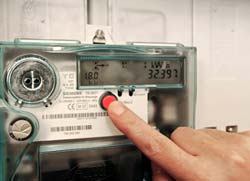Snapshots Make Power Grid More Efficient

Power snapshots from smart meters by Siemens provide synchronous grid information with maximum precision from the low-voltage grid, data that can serve as a basis for analyzing these grids in cities and communities.
Analysis of the collected data makes it possible to use the grid infrastructure more efficiently and to better integrate electric vehicles or the feed-in of power from photovoltaic systems, for example. Siemens developed the power snapshot analyses (PSSA) in collaboration with the Austrian Institute of Technology and several grid operators in Austria. The project received financing from Austria’s Climate and Energy Fund.
In the coming years, the growing number of decentral and fluctuating renewables-based energy sources feeding into the grid, and electric vehicles and electric heating systems will pose an enormous challenge for the power transmission and distribution networks. To estimate how many feed-in sources and how many users a local grid can handle, model simulations are conducted. These models used to be very rudimentary, so big safety margins had to be planned in. For more accurate simulations, detailed data on the low-voltage grids is needed.
That’s why developers from Siemens Austria developed the PSSA, with which the smart meters in local grids were equipped. These meters don’t only record energy-use data; they also generate real-time and synchronous displays of voltages in the local grids at points in time that are critical for the grid technology. The accuracy of the data is unprecedented because the load variations of the phases and the ground return conductor are also recorded. This information on the actual conditions in the grid enables grid operators to more efficiently use the available infrastructure. To compensate for power consumption peaks, the operators can for example take load groups like electric heating systems or heat pumps offline without compromising end users’ convenience. The data also can be used to estimate investment costs for expansions of grid infrastructure.
PSSA will be launched on the market before the end of 2012. Siemens smart meters, which are already being used by many customers, can be equipped with this additional function by means of a firmware download without disturbing the validity of the meters’ calibration.
Media Contact
More Information:
http://www.siemens.com/innovationnewsAll latest news from the category: Power and Electrical Engineering
This topic covers issues related to energy generation, conversion, transportation and consumption and how the industry is addressing the challenge of energy efficiency in general.
innovations-report provides in-depth and informative reports and articles on subjects ranging from wind energy, fuel cell technology, solar energy, geothermal energy, petroleum, gas, nuclear engineering, alternative energy and energy efficiency to fusion, hydrogen and superconductor technologies.
Newest articles

A universal framework for spatial biology
SpatialData is a freely accessible tool to unify and integrate data from different omics technologies accounting for spatial information, which can provide holistic insights into health and disease. Biological processes…

How complex biological processes arise
A $20 million grant from the U.S. National Science Foundation (NSF) will support the establishment and operation of the National Synthesis Center for Emergence in the Molecular and Cellular Sciences (NCEMS) at…

Airborne single-photon lidar system achieves high-resolution 3D imaging
Compact, low-power system opens doors for photon-efficient drone and satellite-based environmental monitoring and mapping. Researchers have developed a compact and lightweight single-photon airborne lidar system that can acquire high-resolution 3D…





















